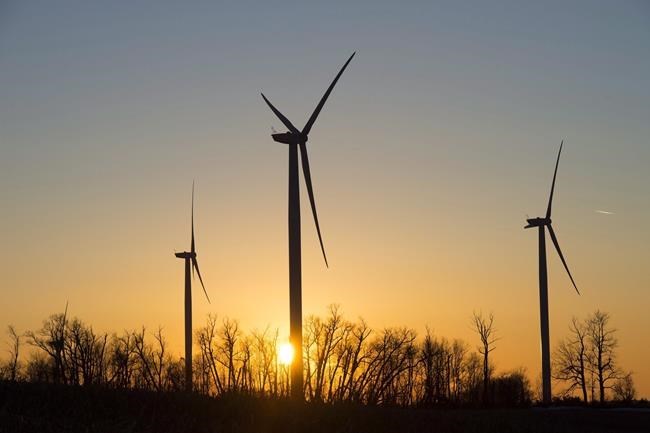TORONTO — Ontario is working toward filling all of the province's quickly growing electricity needs with emissions-free sources, including a plan to secure new renewable generation, but isn't quite ready to commit to a moratorium on natural gas.
Energy Minister Todd Smith announced Monday a strategy to prepare the grid for 2030 to 2050 – the Independent Electricity System Operator projects Ontario's electricity demand could double by mid-century – and next steps involve looking for new wind, solar and hydroelectric power.
"While we may not need to start building today, government and those in the energy sector need to start planning immediately, so we have new clean, zero-emissions projects ready to go when we need them," Smith said in Windsor, Ont.
The strategy also includes two nuclear projects announced last week – a new, large-scale nuclear plant at Bruce Power on the shore of Lake Huron and three new small modular reactors at the site of the Darlington nuclear plant east of Toronto.
Those projects, enough to power six million homes, will help Ontario end its reliance on natural gas to generate electricity, said Smith, but committing to a moratorium in 2027 and eliminating natural gas by 2050 is contingent on the federal government helping to speed up the new nuclear facilities.Â
"Today's report, the Powering Ontario's Growth plan, commits us to working towards a 100 per cent clean grid," Smith said in an interview.
"Hopefully the federal government can get on board with our intentions to build this clean generation as quickly as possible ... That will put us in a much better position to use our natural gas facilities less in the future, if we can get those new projects online."
The IESO has said that natural gas is required to ensure supply and stability in the short to medium term, but that it will also increase greenhouse gas emissions from the electricity sector.Â
The province is expected to face increased demand for electricity from expanded electric vehicle use and manufacturing in the coming years.
Keith Brooks, programs director for Environmental Defence, said the provincial plan could have been much more robust, containing firm timelines and commitments.
"This plan does not commit to getting emissions out of the system," he said.Â
"It doesn't commit to net zero, doesn't set a timeline for a net zero goal or have any projection around emissions from Ontario's electricity sector going forward. In fact, it's not really a plan. It doesn't set out any real goals and it doesn't it doesn't project what Ontario's supply mix might look like."
The 91Ô´´ Climate Institute applauded the plan's focus on reducing reliance on gas-fired generation and emphasizing non-emitting generation, but also said there are still some question marks.
"The plan is silent on whether the province intends to construct new gas-fired generation facilities," senior research director Jason Dion wrote in a statement.Â
"The province should avoid building new gas plants since cost-effective alternatives are available, and such facilities are likely to end up as stranded assets. The province’s timeline for reaching net zero generation is also unclear. Canada and other G7 countries have set a target for 2035, something Ontario will need to address if it wants to remain competitive."
The last round of procurements Smith announced for electricity generation involved both natural gas and battery storage projects. The new planned procurement of green power, including wind, solar, hydroelectric and biogas, will pair well with recent energy storage procurements, Smith said, so that power generated by solar panels, for example, can be stored and injected into the system when needed.
Ontario is also looking at two new pump storage projects, in which water is pumped into a reservoir when electricity demand is low, then released through a turbine to generate electricity when demand is higher. Pump storage can dispatch energy for eight hours, versus four for current battery storage, Smith said.
One prospective pump storage project in Meaford, Ont., by TC Energy in conjunction with Saugeen Ojibway Nation seeks to store enough energy to power one million homes for 11 hours and is expected to be in service in the early 2030s.
Critics say Ontario wouldn't be in as much of an electricity supply crunch if the Progressive Conservative government hadn't cancelled 750 green energy contracts during its first term.
Smith said it was a necessary move at the time.
"We had to cancel those projects when we did," he said. "We had an oversupply of electricity. Demand in the province was flat for 18 years. We were bleeding manufacturing jobs to other jurisdictions and we were paying way over the market price for those projects."
Anger over rising hydro bills was high when the former Liberal government lost the election in 2018, going from a majority to not enough seats needed for official party status in the legislature.Â
The Liberals had given power producers long-term contracts at above-market rates in order to ensure a steady supply, but it meant that rates for consumers rose dramatically while the average electricity market price dropped.
Monday's report also said the IESO will consider new transmission lines, including between Toronto and Sudbury and in the Greater Toronto Area.
This report by The 91Ô´´ Press was first published July 10, 2023.
Allison Jones, The 91Ô´´ Press



